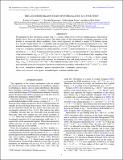THE LAST EIGHT-BILLION YEARS OF INTERGALACTIC Si IV EVOLUTION
Author(s)
Cooksey, Kathy; Prochaska, J. Xavier; Thom, Christopher; Chen, Hsiao-Wen
DownloadCooksey-2011-THE LAST EIGHT-BILLI.pdf (581.0Kb)
PUBLISHER_POLICY
Publisher Policy
Article is made available in accordance with the publisher's policy and may be subject to US copyright law. Please refer to the publisher's site for terms of use.
Terms of use
Metadata
Show full item recordAbstract
We identified 24 Si iv absorption systems with z ≾ 1 from a blind survey of 49 low-redshift quasars with archival Hubble Space Telescope ultraviolet spectra. We relied solely on the characteristic wavelength separation of the doublet to automatically detect candidates. After visual inspection, we defined a sample of 20 definite (group G = 1) and 4 “highly likely” (G = 2) doublets with rest equivalent widths Wr for both lines detected at ≥3σWr. The absorber line density of the G = 1doublets was dNSiiv/dX=1.4+0.4−0.3for log N(Si+3)>12. 9.The best-fit power law to the G = 1 frequency distribution of column densities f(N(Si+3)) had normalization k = (1.2+0.5−0.4)×10−14cm2 and slope α N=−16+0.3−0.3. Using the power-law model off(N(Si+3)), we measured the Si+3 mass density relative to the critical density: Si+3=(3.7+2.8−1.7)×10−8for 13logN(Si+3)15. From Monte Carlo sampling of the distributions, we estimated our value to be a factor of 4.8+3.0−1.9higher than the 2z4.5Si+3. From a simple linear fit to Si+3 over the age of the universe, we estimated a slow and steady increase from z=5.5→0 with dSi+3/d Ω age =(0.61±0.23)×10−8Gyr−1. We compared our ionic ratios N(Si+3)/N(C+3) to a 2<z<4.5 sample and concluded, from survival analysis, that the two populations are similar, with medianN(Si+3)/N(C+3) =0.16.
Date issued
2011-03Department
Massachusetts Institute of Technology. Department of Physics; MIT Kavli Institute for Astrophysics and Space ResearchJournal
Astrophysical Journal
Publisher
Institute of Physics/American Astronomical Society
Citation
Cooksey, Kathy L., J. Xavier Prochaska, Christopher Thom, and Hsiao-Wen Chen. “THE LAST EIGHT-BILLION YEARS OF INTERGALACTIC Si IV EVOLUTION.” The Astrophysical Journal 729, no. 2 (February 14, 2011): 87. © 2011 American Astronomical Society.
Version: Final published version
ISSN
0004-637X
1538-4357